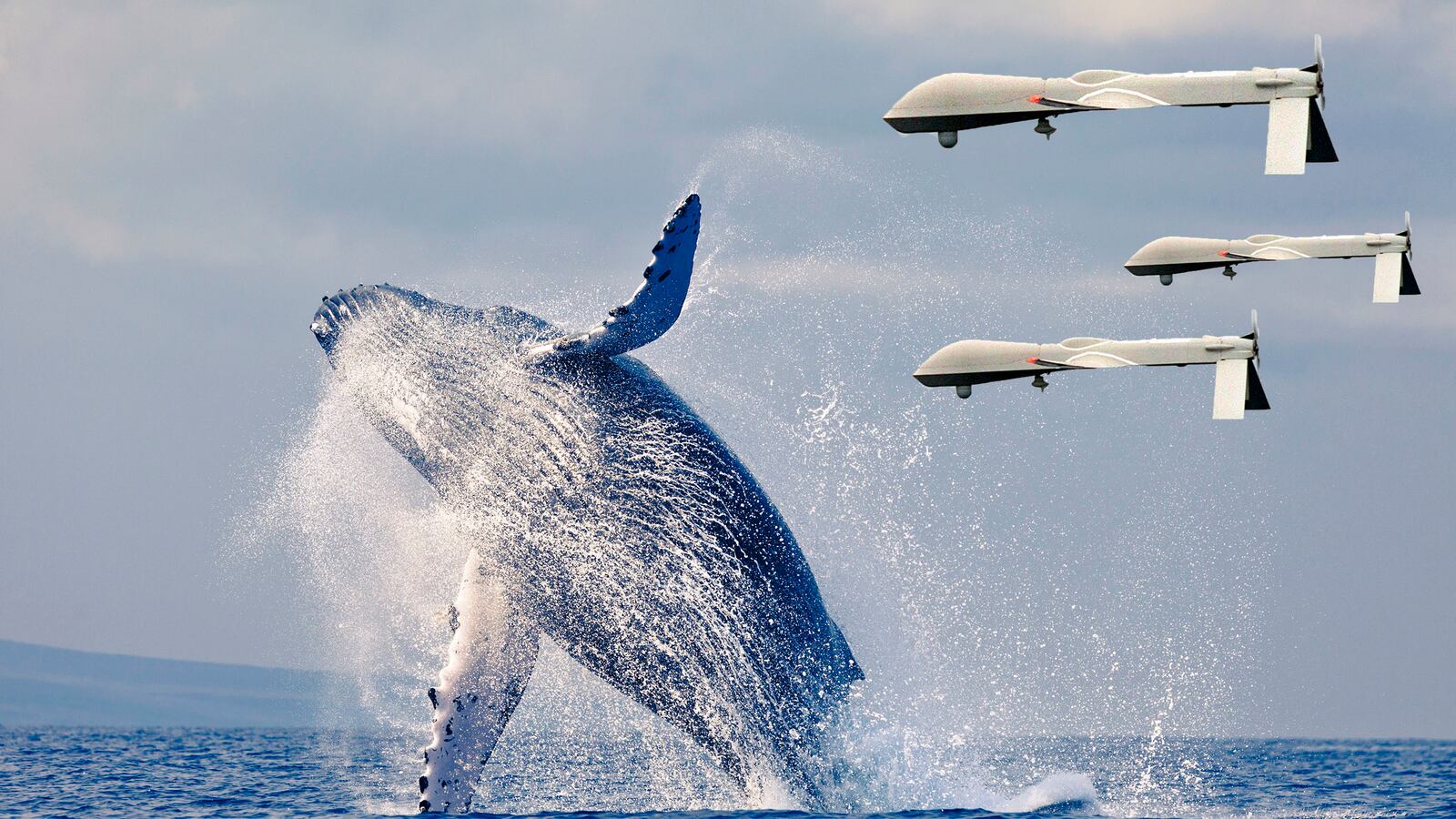Imagine a drone skimming above the ocean waves, steered by scientists on a research ship in the distance. As it approaches a pod of sperm whales surfacing after a long dive, it homes in on a single animal and touches down on the cetacean’s broad back. An automated device attaches a suction-cup tag to the whale’s skin, then takes off again, leaving the radio tag firmly attached. Now researchers can track the whale at a distance throughout its long migration—non-invasively, quietly, and without ever approaching the creature in person.
The technology to use drones to track whales, or any other kind of animal, is still years away—but Wayne Perryman, a marine biologist at the National Oceanic and Atmospheric Administration, is convinced that drones will soon be a regular part of his job. Perryman already uses unmanned aircraft to study leopard seals and killer whales, taking aerial photographs from far above a seal on the hunt or a pod of migrating whales.
“Humans are notorious for being lousy at estimating numbers of animals in large groups,” Perryman explains. “But you can take an aerial photograph and count them really easily.”
Perryman believes that the work he does—studying large, social marine animals across a range that stretches from Antarctica to the coast of British Columbia—is soon to be transformed by unmanned aircraft, now that drones are becoming widely available commercially. “It’ll become a common tool that we take in the field, just like we take a pair of binoculars,” Perryman told The Daily Beast. “We’re just limited by our imagination.”
Perryman isn’t alone in his anticipation. Andrew Thaler, a freelance scientist who writes for Motherboard, has argued that autonomous drones could transform not only research but also eco-tourism. In one column, he floats ideas like a drone-enabled whale watching tour, which would keep tourists at a distance from sensitive animals while offering unparalleled aerial footage.
But not everyone is thrilled with the prospect of a drone in every marine biologist’s hangar, especially around wild animals. Earlier this summer, the National Parks Service directed its superintendents to prohibit unmanned aircraft in all of the country’s 140 parks. The decision came in the wake of several cases in which drone enthusiasts flew their aircraft over visitors’ heads, around herds of protected animals, and along the rim of the Grand Canyon.
On one occasion, a drone operator flew a drone over a crowd at Mount Rushmore, then out over the monument itself. “If this thing had crashed, they weigh a minimum of three to five pounds. If they fell from a height of even a hundred feet, someone could have been seriously injured,” Jeffrey Olson, a spokesperson for the parks service, told The Daily Beast. “Also, Mount Rushmore is an iconic national treasure. Crashing things into national treasures is not a good thing, at the very least.”
In another case last spring, a drone buzzed around a herd of bighorn sheep in Zion National Park, spooking the sheep and separating several lambs from the rest of the herd.
In addition, FAA regulations and a piece of legislation called the Marine Mammal Protection Act make it effectively impossible for projects like drone whale-watching tours to function legally. According to the FAA, amateur drone operators are advised to fly their craft below 400 feet. But under the Marine Mammal Protection Act, aircraft are required to maintain an altitude of at least 1000 feet above protected marine species, including whales. The combination of the two rules, as they stand now, adds up to a de facto ban on approaching marine animals aerially.
“We’ve got these very cool new technologies that can be very helpful for marine conservation, but the laws haven’t quite caught up yet,” Thaler told the Beast. “Regulators need to put some effort into figuring out how they’re going to treat drones when they’re talking about interacting with marine mammals.”
Debates about the research uses of unmanned aircraft may seem superfluous compared to the ongoing drone strikes in Iraq and the potential privacy concerns that come along with drones’ increased commercial availability. But the complicated regulatory environment highlighted by science-related drone use echoes a set of issues that will only grow as drone technology improves.
Done right, the FAA’s guidelines should allow scientific research and innovation in business while protecting citizens’ privacy. Done wrong, they risk pushing away companies that want to invest in research and development on drones. For example, Amazon has hinted that unless the FAA agrees to exempt the company from some federal drone rules, the company will take its research and development projects abroad.
In the meantime, certain rules of thumb about drone use are self-evident. For instance, Perryman would never use the close-range drone tagging system he envisions with the leopard seals he already studies from the sky. A leopard seal is “about a thousand-pound animal with lots of teeth,” Perryman explains. “[It] would probably jump out of the water and bite it.






